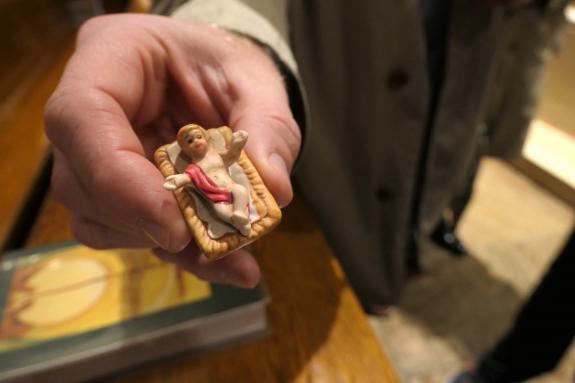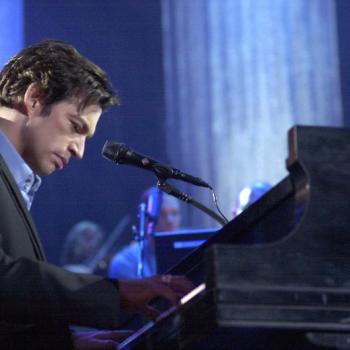Well, this was different. Before Mass today, one of the priests was casting about for a homily idea. “Well, if I were you, I’d preach about Bambinelli Sunday,” I told him. His eyes lit up. “You want to preach?,” he asked me eagerly. “Sure,” I said, having only the vaguest idea of what I would say. I wasn’t scheduled and hadn’t really prepared anything. I printed out a text from the Vatican website and, without much preparation beyond a quick cursory read, climbed into the pulpit and winged it (though most of the homily was, in fact, written by St. John Paul.)
Here’s the reconstruction of what I said.
+
On this Sunday 40 years ago, Gaudete Sunday of 1978, a man who had made history just a few months earlier, when he was elected pope, made history once again.
On that Sunday, Pope John Paul started a new tradition. He invited the children of Rome to bring to Vatican Square the infant Jesus from their family Nativity scenes, so he could bless them. That became the first Bambinelli Sunday — and now, 40 years alter, the tradition continues here in this parish. We will be blessing the bambinelli, the little babies, at the end of every Mass.
It is a fitting celebration for this Sunday of rejoicing. And this Sunday, to makr it, I’m going to do something different. I want to share with you St. John Paul’s address to the children of Rome on that Sunday 40 years ago.
It’s rare that I read somebody else’s words in a homily — in fact, this may be the first time I’ve done it — but I think John Paul’s words are worth hearing and have something to say to us today.
And, as I like to tell people, I only steal from the best.
The pope began by thanking the children who came. And then he offered some history — which today gives us a beautiful example of one saint speaking about another saint.
Here’s what he said:
The first representation of the Crib sprung, as you know, from the brilliant intuition of St Francis of Assisi. Deeply struck and moved by the humility of the Incarnation, on Christmas night in 1223 he got a faithful and pious friend called John to bring to Greccio all that was necessary: straw, hay, the manger and an ox and a donkey in flesh and blood. “I would like”—the Saint said—”to represent the Infant Jesus born in Bethlehem, and to see, so to speak, with the eyes of the body the hardships he suffered for lack of the things a new-born child needs, how he was put in a manger and how he lay in the hay between the ox and the donkey” (Tommaso da Celano, Vita Prima, n. 84). Various friars came to the place; men and women arrived rejoicing from the lonely cottages in the region, carrying candles and torches to illuminate that night on which, as the biographer notes further, “there shone forth splendid in the sky the Star that illuminated all days and times”. A priest celebrated the Eucharist and Francis of Assisi, who was a Deacon, sang the Holy Gospel with his strong, sweet voice, clear and resounding,
From Greccio, which had become like a new Bethlehem, the representation of the Crib, which had sprung from the heart of a Saint, capable of realizing the most sublime poetry in life, spread throughout Italy, Europe and the whole world. It kept intact, in the various expressions of culture and folklore, the fundamental message, truly evangelical, which Francis wanted souls to grasp from contemplation of the Crib, a school of simplicity, poverty, and humility.
Modern society is not always, unfortunately, supporter and messenger of these attitudes, which are sometimes considered even as weaknesses or as frustrations of the human personality. Yet the Son of God, to meet man, to walk by his side, to save him, chose the absolute emptying of his personality, the total lack of means and human instruments, the struggle against pride and arrogance.
As I bless your little statues, beloved children, I think with serene hope of you, of the immense good that you can do, precisely because you are little, within your family, the school, the Associations, and society itself. Not for nothing did Jesus himself choose you as models for those who wish to have a part in his Kingdom (cf. Mt 18:4; Mk 10: 15).
Take home, with great care, the little statue of the Infant Jesus, also as a sign of the Pope’s love for you and your families. Put it in your Crib with intense faith, with that faith wherewith the Blessed Virgin, the Mother of God, laid the new-born Jesus in the manger (cf. Lk 2:7). Invite your father, your mother, your brothers and sisters, the whole of your family, to gather round the Crib in these days of the Christmas Novena, to recite together the prayers learned on your mother’s lap, to sing the sweet carols, so charged with human and Christian sentiment.
May the Infant Jesus, present in the Crib of your home, be the concrete sign of sincere faith, which will enlighten, guide and direct your life and that of your dear ones.
Well, there’s not much I can add to that.
But I do want to reflect for just a moment on that one recurring word in the letter from St. Paul, which gives us the theme of this Sunday:
“Rejoice!”
Incredibly, he wrote that letter from prison. That sentiment may not be the first most of us would think of behind prison walls. But it calls out to us, in whatever prison we find ourselves, whatever difficulty we face, whatever challenges we confront: rejoice, because the Lord is near. He is never far from us.
May we hold fast to that simple idea. As we encounter the image of the Christ child in Nativity scenes this season — and we will be seeing him in our homes, our churches, on Christmas cards —wherever we see the “bambinelli,” may we be reminded that Jesus is near, that God is near. As I say so often during this season, the Messiah’s name, Emmanuel, means “God with us.” He is.
For that reason alone, let us hold Paul’s words close to our hearts:
“Rejoice! Again, I say, rejoice!”













